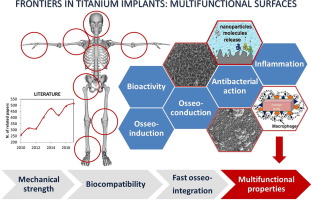Acta Biomaterialia ( IF 9.7 ) Pub Date : 2018-08-17 , DOI: 10.1016/j.actbio.2018.08.013 Silvia Spriano , Seiji Yamaguchi , Francesco Baino , Sara Ferraris

|
Evolution of metal implants progressively shifted the focus from adequate mechanical strength to improved biocompatibility and absence of toxicity and, finally, to fast osseointegration. Recently, new frontiers and challenges of Ti implants have been addressed to improvement of bioactivity, fighting of bacterial infection and biofilm formation, as well as modulation of inflammation. This is closely related to the clinical demand of multifunctional implants able to simultaneously have a number of specific responses with respect to body fluids, cells (osteoblasts, fibroblasts, macrophages) and pathogenic agents (bacteria, viruses). This complex system of multiple biological stimuli and surface responses is a major arena of the current research on biomaterials and biosurfaces. This review covers the strategies explored to this purpose since 2010 in the case of Ti and Ti alloys, considering that the number of related papers doubled about in the last seven years and no review has comprehensively covered this engaging research area yet. The different approaches followed for producing multifunctional Ti-based surfaces involve the use of thick and thin inorganic coatings, chemical surface treatments, and functionalization strategies coupled with organic coatings.
Statement of significance
According to the clinical demand of multifunctional implants able to simultaneously have a number of specific responses with respect to body fluids, cells and pathogenic agents, new frontiers of Ti implants have been addressed to improvement of bioactivity, fighting of bacterial infection and biofilm formation, as well as modulation of inflammation. Literature since 2010 is here reviewed. Several strategies for getting bioactive and antibacterial actions on Ti surfaces have been suggested, but they still need to be optimized with respect to several concerns. A further step will be to combine on the same surface a proven ability of modulation of inflammatory response. The achievement of multifunctional surfaces able to modulate inflammation and to promote osteogenesis is a grand challenge.
中文翻译:

多功能钛表面的严格审查:改善骨整合和宿主反应,避免细菌污染的新领域
金属植入物的发展逐渐将焦点从足够的机械强度转移到改善的生物相容性和无毒性,最后转移到快速骨整合。近来,Ti植入物的新领域和挑战已经被解决以提高生物活性,对抗细菌感染和生物膜形成以及调节炎症。这与多功能植入物的临床需求密切相关,多功能植入物能够对体液,细胞(成骨细胞,成纤维细胞,巨噬细胞)和病原体(细菌,病毒)同时具有多种特异性反应。这种具有多种生物刺激和表面反应的复杂系统是当前对生物材料和生物表面的研究的主要领域。考虑到相关论文的数量在过去七年中翻了一番,而且还没有一篇综述全面涵盖这一引人入胜的研究领域,因此本综述涵盖了自2010年以来针对Ti和Ti合金为此目的探索的策略。生产多功能钛基表面所采用的不同方法包括使用厚的和薄的无机涂层,化学表面处理以及与有机涂层结合的功能化策略。
重要声明
根据能够同时对体液,细胞和病原体产生多种特定反应的多功能植入物的临床需求,Ti植入物的新领域已被提出来改善生物活性,对抗细菌感染和生物膜形成,例如以及炎症调节。这里回顾了自2010年以来的文献。已经提出了几种在Ti表面上获得生物活性和抗菌作用的策略,但是仍然需要针对几个方面进行优化。进一步的步骤将是在同一表面上结合已证明的调节炎症反应的能力。能够调节炎症并促进成骨的多功能表面的实现是一个巨大的挑战。



























 京公网安备 11010802027423号
京公网安备 11010802027423号